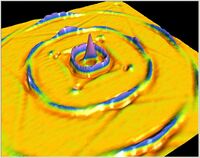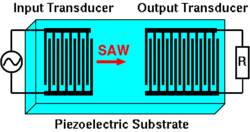Surface acoustic wave

A surface acoustic wave (SAW) is an acoustic wave traveling along the surface of a material exhibiting elasticity, with an amplitude that typically decays exponentially with depth into the material. Materials with relatively high magnitude of Young's modulus (e.g., buildings) can be destructed once exposed to strong SAWs (as in earthquakes), whereas, those with relatively low Young's modulus (e.g., bubbles,[2]and biological cells[3]) can start to oscillate when driven by weak SAWs.
Discovery
SAWs were first explained in 1885 by Lord Rayleigh, who described the surface acoustic mode of propagation and predicted its properties in his classic paper.[4] Named after their discoverer, Rayleigh waves have a longitudinal and a vertical shear component that can couple with any media in contact with the surface. This coupling strongly affects the amplitude and velocity of the wave, allowing SAW sensors to directly sense mass and mechanical properties.
SAW devices
SAW devices use SAW in electronic components to provide a number of different functions, including delay lines[disambiguation needed], filters, correlators and DC to DC converters.
Application in electronic components
This kind of wave is commonly used in devices called SAW devices in electronic circuits. SAW devices are used as filters, oscillators and transformers, devices that are based on the transduction of acoustic waves. The transduction from electric energy to mechanical energy (in the form of SAWs) is accomplished by the use of piezoelectric materials.
Electronic devices employing SAWs normally use one or more interdigital transducers (IDTs) to convert acoustic waves to electrical signals and vice versa by exploiting the piezoelectric effect of certain materials (quartz, lithium niobate, lithium tantalate, lanthanum gallium silicate, etc.).[5] These devices are fabricated by photolithography, the process used in the manufacture of silicon integrated circuits.
SAW filters are now used in mobile telephones, and provide significant advantages in performance, cost, and size over other filter technologies such as quartz crystals (based on bulk waves), LC filters, and waveguide filters.
Much research has been done in the last 20 years in the area of surface acoustic wave sensors.[6] Sensor applications include all areas of sensing (such as chemical, optical, thermal, pressure, acceleration, torque and biological). SAW sensors have seen relatively modest commercial success to date, but are commonly commercially available for some applications such as touchscreen displays.
SAW device applications in radio and television
SAW resonators are used in many of the same applications in which quartz crystals are used, because they can operate at higher frequency.[7] They are often used in radio transmitters where tunability is not required. They are often used in applications such as garage door opener remote controls, short range radio frequency links for computer peripherals, and other devices where channelization is not required. Where a radio link might use several channels, quartz crystal oscillators are more commonly used to drive a phase locked loop. Since the resonant frequency of a SAW device is set by the mechanical properties of the crystal, it does not drift as much as a simple LC oscillator, where conditions such as capacitor performance and battery voltage will vary substantially with temperature and age.
SAW filters are also often used in radio receivers, as they can have precisely determined and narrow passbands. This is helpful in applications where a single antenna must be shared between a transmitter and a receiver operating at closely spaced frequencies. SAW filters are also frequently used in television receivers, for extracting subcarriers from the signal; until the analog switchoff, the extraction of digital audio subcarriers from the intermediate frequency strip of a television receiver or video recorder was one of the main markets for SAW filters.
Early pioneer Jeffery Collins incorporated surface acoustic wave devices in a Skynet receiver he developed in the 1970s. It synchronised signals faster than existing technology.[8]
They are also often used in digital receivers, and are well suited to superhet applications. This is because the intermediate frequency signal is always at a fixed frequency after the local oscillator has been mixed with the received signal, and so a filter with a fixed frequency and high Q provides excellent removal of unwanted or interference signals.
In these applications, SAW filters are almost always used with a phase locked loop synthesized local oscillator, or a varicap driven oscillator.
SAW in geophysics
In seismology surface acoustic waves travelling along the Earth's surface play an important role, since they can be the most destructive type of seismic wave produced by earthquakes.[9]
SAW in microfluidics
In recent years, attention has been drawn to using SAWs to drive microfluidic actuation and a variety of other processes. Owing to the mismatch of sound velocities in the SAW substrate and fluid, SAWs can be efficiently transferred into the fluid, creating significant inertial forces and fluid velocities. This mechanism can be exploited to drive fluid actions such as pumping, mixing, and jetting.[8] To drive these processes, there is a change of mode of the wave at the liquid-substrate interface. In the substrate, the SAW wave is a transverse wave and upon entering the droplet the wave becomes a longitudinal wave.[9] It is this longitudinal wave that creates the flow of fluid within the microfluidic droplet, allowing mixing to take place. This technique can be used as an alternative to microchannels and microvalves for manipulation of substrates, allowing for an open system.[10]
This mechanism has also been used in droplet-based microfluidics for droplet manipulation. Notably, using SAW as an actuation mechanism, droplets were pushed towards two[11][12] or more[13] outlets for sorting. Moreover, SAWs were used for droplet size modulation[14][15], splitting,[16][11][17] trapping,[18] tweezing,[19] and nanofluidic pipetting.[17]
PDMS (polydimethylsiloxane) is a material that can be used to create microchannels and microfluidic chips. It has many uses, including in experiments where living cells are to be tested or processed. If living organisms need to be kept alive, it is important to monitor and control their environment, such as heat and pH levels; however, if these elements are not regulated, the cells may die or it may result in unwanted reactions.[20] PDMS has been found to absorb acoustic energy, causing the PDMS to heat up quickly (exceeding 2000 Kelvin/second).[21] The use of SAW as a way to heat these PDMS devices, along with liquids inside microchannels, is now a technique that can be done in a controlled manner with the ability to manipulate the temperature to within 0.1 °C.[21][22]
Under relatively low amplitude SAWs, adherent cells cultured inside a PDMS channel can generate microstreaming flow in the surrounding liquid. The velocity magnitude of this flow is shown to be directly related to the stiffness of the cells.[23]
SAW in flow measurement
Surface acoustic waves can be used for flow measurement. SAW relies on the propagation of a wave front, which appears similar to seismic activities. The waves are generated at the excitation centre and spread out along the surface of a solid material. An electric pulse induces them to generate SAWs that propagate like the waves of an earthquake. Interdigital transducer acts as sender and as receiver. When one is in sender mode, the two most distant ones act as receivers. The SAWs travel along the surface of the measuring tube, but a portion will couple out to the liquid. The decoupling angle depends on the liquid respectively the propagation velocity of the wave which is specific to the liquid. On the other side of the measuring tube, portions of the wave will couple into the tube and continue their way along its surface to the next interdigital transducer. Another portion will be coupled out again and travels back to the other side of the measuring tube where the effect repeats itself and the transducer on this side detects the wave. That means excitation of any one transducer here will lead to a sequence of input signals on two other transducers in the distance. Two of the transducers send their signals in the direction of flow, two in the other direction.[24]
See also
References
- ↑ Applied Solid State Physics Laboratory - Hokkaido University. Kino-ap.eng.hokudai.ac.jp (2013-11-28). Retrieved on 2013-12-09.
- ↑ D. Ahmed, X. Mao, J. Shi, B. Krishna, T. Huang, A Millisecond Micromixer via Single-Bubble-Based Acoustic Streaming, Lab Chip (2009)
- ↑ Salari, A.; Appak-Baskoy, S.; Ezzo, M.; Hinz, B.; Kolios, M.C.; Tsai, S.S.H. Dancing with the Cells: Acoustic Microflows Generated by Oscillating Cells, Small (2019). https://doi.org/10.1002/smll.201903788
- ↑ Lord Rayleigh (1885). "On Waves Propagated along the Plane Surface of an Elastic Solid". Proc. London Math. Soc. s1-17 (1): 4–11. doi:10.1112/plms/s1-17.1.4. http://plms.oxfordjournals.org/cgi/reprint/s1-17/1/4.
- ↑ Weigel, R.; Morgan, D.P.; Owens, J.M.; Ballato, A.; Lakin, K.M.; Hashimoto, K.; Ruppel, C.C.W. (2002). "Microwave acoustic materials, devices, and applications". IEEE Transactions on Microwave Theory and Techniques 50 (3): 738–749. doi:10.1109/22.989958. Bibcode: 2002ITMTT..50..738W.
- ↑ Benes, E.; Gröschl, M.; Seifert, F. (1998). "Comparison Between BAW and SAW Sensor Principles". IEEE Trans. Ultrason. Ferro. Freq. Control 45: 5–20. doi:10.1109/FREQ.1997.638514. ISBN 978-0-7803-3728-2.
- ↑ Biryukov, S.V.; Gulyaev, Y.V.; Krylov, V.V.; Plessky, V.P. (1995). Surface Acoustic Waves in Inhomogeneous Media. Springer. ISBN 9783540584605. https://books.google.com/?id=WR-jfwMnDYYC.
- ↑ "Jeffrey Collins Obituary Herald Newspaper". http://www.heraldscotland.com/opinion/obituaries/13795040.Jeffrey_Collins/.
- ↑ Aki, Keiiti; Richards, Paul G. (1980). Quantitative seismology. Freeman.
- ↑ Yang, Chun-Guang; Xu, Zhang-Run; Wang, Jian-Hua (February 2010). "Manipulation of droplets in microfluidic systems". TrAC Trends in Analytical Chemistry 29 (2): 141–157. doi:10.1016/j.trac.2009.11.002.
- ↑ 11.0 11.1 Sesen, Muhsincan; Alan, Tuncay; Neild, Adrian (2015). "Microfluidic plug steering using surface acoustic waves". Lab on a Chip 15 (14): 3030–3038. doi:10.1039/c5lc00468c. ISSN 1473-0197. PMID 26079216.
- ↑ Franke, Thomas; Abate, Adam R.; Weitz, David A.; Wixforth, Achim (2009). "Surface acoustic wave (SAW) directed droplet flow in microfluidics for PDMS devices" (in en). Lab on a Chip 9 (18): 2625–7. doi:10.1039/b906819h. ISSN 1473-0197. PMID 19704975.
- ↑ Ding, Xiaoyun; Lin, Sz-Chin Steven; Lapsley, Michael Ian; Li, Sixing; Guo, Xiang; Chan, Chung Yu; Chiang, I-Kao; Wang, Lin et al. (2012). "Standing surface acoustic wave (SSAW) based multichannel cell sorting" (in en). Lab on a Chip 12 (21): 4228–31. doi:10.1039/c2lc40751e. ISSN 1473-0197. PMID 22992833.
- ↑ Schmid, Lothar; Franke, Thomas (2013). "SAW-controlled drop size for flow focusing" (in en). Lab on a Chip 13 (9): 1691–4. doi:10.1039/c3lc41233d. ISSN 1473-0197. PMID 23515518.
- ↑ Schmid, Lothar; Franke, Thomas (2014-03-31). "Acoustic modulation of droplet size in a T-junction" (in en). Applied Physics Letters 104 (13): 133501. doi:10.1063/1.4869536. ISSN 0003-6951. Bibcode: 2014ApPhL.104m3501S.
- ↑ Jung, Jin Ho; Destgeer, Ghulam; Ha, Byunghang; Park, Jinsoo; Sung, Hyung Jin (2016). "On-demand droplet splitting using surface acoustic waves" (in en). Lab on a Chip 16 (17): 3235–3243. doi:10.1039/C6LC00648E. ISSN 1473-0197. PMID 27435869. https://semanticscholar.org/paper/9e41d2525691ddbb0be017fc370199a803ab9e09.
- ↑ 17.0 17.1 Sesen, Muhsincan; Devendran, Citsabehsan; Malikides, Sean; Alan, Tuncay; Neild, Adrian (2017). "Surface acoustic wave enabled pipette on a chip". Lab on a Chip 17 (3): 438–447. doi:10.1039/c6lc01318j. ISSN 1473-0197. PMID 27995242.
- ↑ Jung, Jin Ho; Destgeer, Ghulam; Park, Jinsoo; Ahmed, Husnain; Park, Kwangseok; Sung, Hyung Jin (2017-02-21). "On-Demand Droplet Capture and Release Using Microwell-Assisted Surface Acoustic Waves" (in en). Analytical Chemistry 89 (4): 2211–2215. doi:10.1021/acs.analchem.6b04542. ISSN 0003-2700. PMID 28192923.
- ↑ Sesen, Muhsincan; Alan, Tuncay; Neild, Adrian (2014). "Microfluidic on-demand droplet merging using surface acoustic waves". Lab Chip 14 (17): 3325–3333. doi:10.1039/c4lc00456f. ISSN 1473-0197. PMID 24972001. https://semanticscholar.org/paper/6035688e0abaafca8a6e980105229f6219d083c8.
- ↑ Hagen, Stephen J; Son, Minjun (27 January 2017). "Origins of heterogeneity in competence: interpreting an environment-sensitive signaling pathway". Physical Biology 14 (1): 015001. doi:10.1088/1478-3975/aa546c. PMID 28129205. Bibcode: 2017PhBio..14a5001H.
- ↑ 21.0 21.1 Ha, Byung Hang; Lee, Kang Soo; Destgeer, Ghulam; Park, Jinsoo; Choung, Jin Seung; Jung, Jin Ho; Shin, Jennifer Hyunjong; Sung, Hyung Jin (3 July 2015). "Acoustothermal heating of polydimethylsiloxane microfluidic system". Scientific Reports 5 (1): 11851. doi:10.1038/srep11851. PMID 26138310. Bibcode: 2015NatSR...511851H.
- ↑ Yaralioglu, Goksen (November 2011). "Ultrasonic heating and temperature measurement in microfluidic channels". Sensors and Actuators A: Physical 170 (1–2): 1–7. doi:10.1016/j.sna.2011.05.012.
- ↑ Salari, A.; Appak-Baskoy, S.; Ezzo, M.; Hinz, B.; Kolios, M.C.; Tsai, S.S.H. Dancing with the Cells: Acoustic Microflows Generated by Oscillating Cells, Small (2019). https://doi.org/10.1002/smll.201903788
- ↑ Product from Bürkert Fluid Control Systems http://www.processindustryforum.com/article/patented-flow-meter-saw-technology-accurate-flow-measurement-hygienic-applications
External links


